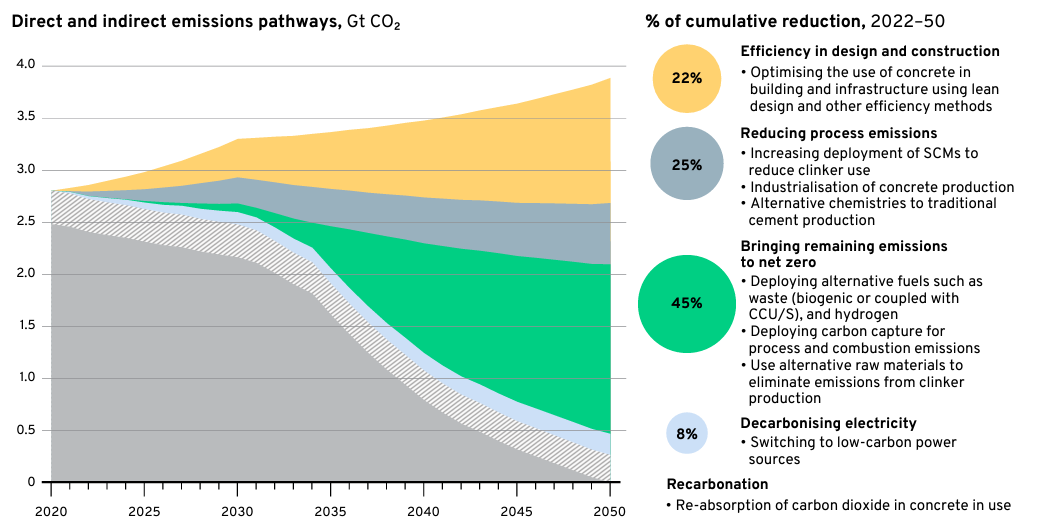
Ten of the world's largest concrete companies and cement plants have joined forces to drive forward a roadmap towards net zero emissions in the concrete and cement production process.
The likes of Heidelberg, Cemex and Holcim have teamed up with architects and engineers to support the work of the Mission Possible Partnership (MPP), which aims to develop a new strategy that sets out the milestones and commitments needed by government, industry and investors over the next 25 years to make net zero concrete and cement a reality.
"Our report sets out precisely what needs to happen to make zero carbon concrete and cement a reality, but time is not on our side," says Faustine Delasalle, CEO of the MPP. "The moment to roll up our sleeves and work together across the value chain and with governments is now. Immediate collaboration and cooperation - from producers through design and construction - together with policymakers and finance - is essential to making the necessary progress this decade."
After water, concrete is the world's most widely used material, while cement is a critical material for buildings, transportation and other infrastructure. The sector currently generates 8% of global CO2 emissions - more than aviation and shipping combined - and demand is projected to increase by 50% by 2050. To tackle this challenge, the 'Making Net Zero Concrete and Cement Possible' roadmap will demonstrate how the sector can reach net zero GHG emissions and comply with a 1.5°C target if urgent action is taken across three levers: demand, supply, and carbon capture utilisation and storage (CCUS).
According to the MPP, emissions could be reduced by 22% on the demand side through efficiency improvements in construction and design to reduce the volume of concrete needed in various applications without compromising safety or durability. Meanwhile, a 25% reduction can be achieved in process emissions on the supply side by utilising Supplementary Cementing Materials (SCMs) to decrease the use of clinker and bring alternative chemistries to commercial stage. Additionally, the MPP predicts that 53% of emissions could be reduced, eliminated or captured through a combination of fuel switch, power sector decarbonisation and CCUS technologies.
The promise of CCUS
The MPP states that CCUS currently has the largest emissions saving potential of all available technologies. To ensure the industry stays within its carbon budget, between 33-45 new CCUS plants with an annual capacity of 80 megatonnes of CO2 must be in operation by 20230, the partnership says. However, new data from MPP's tracking of green industrial projects shows that the current pipeline falls short as projects struggle to reach Final Investment Decision (FID). In fact, 15 plants have so far reached this critical point. As a result, MPP is calling for immediate action across the concrete production value chain from industry, governments and financial institutions worldwide to create an enabling environment for innovation and decarbonisation.
"Collective acknowledgement for the strategy, from a wide variety of companies and the largest in the concrete and cement sector reflects the growing momentum of business for action in the near term," added Delasalle. "Making Net Zero Concrete and Cement Possible joins a series of industry transition strategies, backed by 200+ industry players and developed by MPP to guide decarbonisation of seven hardest-to-abate sectors."
Important milestones
The roadmap lays out several near-term milestones that the MPP believes will help to achieve this goal. By 2025, Governments should permit the increased use of SCMs and use procurement power to bring about deployment. Concrete demand will be reduced by 4% compared with business-as-usual, and CO2 transport and storage plans will be in place and under construction across three regions.
By 20230, the MPP envisages 33-45 commercial scale carbon capture plants to be operational, and concrete demand to have peaked and starting to decrease globally. Global average clinker-binder ratio will have dropped to a global average of 0.54-0.58 from 0.63 today. And by 2035, there should be a 35% reduction in emissions achieved if the previous milestones have been met.
Miljan Gutovic, Holcim Region Head Europe, added: "At Holcim, we are at the forefront of decarbonising building across its entire lifecycle to build better with less, from our own operations to low carbon construction, all the way to energy-efficient buildings in use. The MPP sector transition strategies provide a pathway showcasing how companies and policymakers can collaborate to accelerate decarbonisation."





